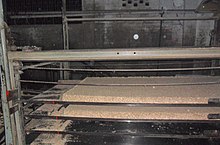Particle board
This article needs additional citations for verification. (November 2007) |

Particle board, also known as particleboard, chipboard, and low-density fiberboard, is an
Characteristics

Particle board is cheaper,
A significant disadvantage of particleboard is its susceptibility to expansion and discoloration from moisture absorption, particularly when it is not covered with paint or another sealer. Therefore, it is rarely used outdoors or in places where there are high levels of moisture, except in bathrooms, kitchens and laundries, where it is commonly used as an underlayment shielded beneath a moisture resistant continuous sheet of vinyl flooring.
In dry environments, veneered particleboard is preferred over veneered plywood because of its stability, lower cost, and convenience.
History and development
The history of particleboard is unclear. The nineteenth century saw many attempts to make use of sawmill by-products, including sawdust and wood chips, by manufacturing composite boards; conceptual references to processes of manufacturing wood composites similar to particleboard date from 1887.[2] In 1935, Farley and Loetscher Manufacturing Co. became the first plant to manufacture particleboard.[3] A particleboard industry developed over the course of the 1940s.[4]
In 1932, Luftwaffe pilot and inventor Max Himmelheber patented a process for making particleboard without fully impregnating wood fibers with adhesive, distinguishing it from earlier wood composites.[5] This particleboard could be produced with waste products such as planer shavings, off-cuts or sawdust, hammer-milled into chips and bound together with a phenolic resin. Hammer-milling involves smashing material into smaller and smaller pieces until they can pass through a screen. Most early particleboard manufacturers used similar processes, though often with slightly different resins.
It was found that better strength, appearance and resin economy could be achieved by using more uniform, manufactured chips. Producers began processing solid birch, beech, alder, pine and spruce into consistent chips and flakes; these finer layers were then placed on the outside of the board, with its core composed of coarser, cheaper chips. This type of board is known as three-layer particleboard.

More recently,[when?] graded-density particleboard has also evolved. It contains particles that gradually become smaller as they get closer to the surface.
Manufacturing
Particleboard or chipboard is manufactured by mixing particles or flakes of wood or
Panel production involves other chemicals including wax, dyes, wetting agents and release agents, to aid processing or make the final product resistant to water, fire or insects.
After the particles pass through a mist of resin sufficient to coat all surfaces, they are layered into a continuous carpet. This 'carpet' is then separated into discrete, rectangular 'blankets' which will be compacted in a cold press. A scale weighs the flakes, and they are distributed by rotating rakes. In graded-density particleboard, the flakes are spread by an air jet that throws finer particles further than coarse ones. Two such jets, reversed, allow the particles to build up from fine to coarse and back to fine.
The formed sheets are cold-compressed to reduce thickness and make them easier to transport. Later, they are compressed again, under pressures between 2 and 3 megapascals (290 and 440 psi) and temperatures between 140 and 220 °C (284 and 428 °F) to set and harden the glue. The entire process is controlled to ensure the correct size, density and consistency of the board.
The boards are then cooled, trimmed and sanded. They can then be sold as raw board or surface improved through the addition of a wood veneer or laminate surface.
Furniture design
] Once the technology was more developed, particle board became cheaper.Some large companies base their strategies around providing furniture at a low price. To do this, they use the least expensive materials possible. In almost all cases, this means particle board, medium-density fibreboard (MDF), or the like. However, in order to maintain a reputation for quality at low cost, manufacturers may use higher grades of particle board, e.g., higher density particle board, thicker particle board, or particle board using higher-quality resins. One may note the amount of sag in a shelf of a given width in order to draw the distinction.
In general, the much lower cost of sheet goods (particle board, medium density fiberboard, and other engineered wood products) has helped to displace solid wood from many cabinetry applications.
Safety
Safety concerns exist for both manufacturing and use. Fine dust and chemicals are released when particleboard is machined (e.g., sawing or routing). Occupational exposure limits exist in many countries recognizing the hazard of wood dusts.[6] Cutting particle board can release formaldehyde, carbon monoxide, hydrogen cyanide in the case of amino resins, and phenol in the case of phenol formaldehyde resins.[7]
The other safety concern is the slow release of formaldehyde over time. In 1984 concerns about the high indoor levels of formaldehyde in new
See also
References
- ^ "Wood based panel producers in Poland". sppd.pl.
- JSTOR 3179639.
- JSTOR 23317191.
- ISBN 978-1-4398-5381-8.
- ^ "Wood-like mass and process for its production".
- ^ "Wood dust hazards" (PDF). UK HSE. Archived from the original (PDF) on 2009-12-29.
- ^ McCann, Michael; Babin, Angela (1995). "Certified Master Woodworker". The University of Illinois at Chicago. Retrieved June 19, 2019.
- ^ "Formaldehyde Factsheet" (webpage). Illinois Department of Public Health.
- ^ IARC Monographs on the Evaluation of Carcinogenic Risks to Humans Volume 88 (2006) Formaldehyde, 2-Butoxyethanol and 1-tert-Butoxypropan-2-ol (pdf, html), WHO Press, 2006( English )
